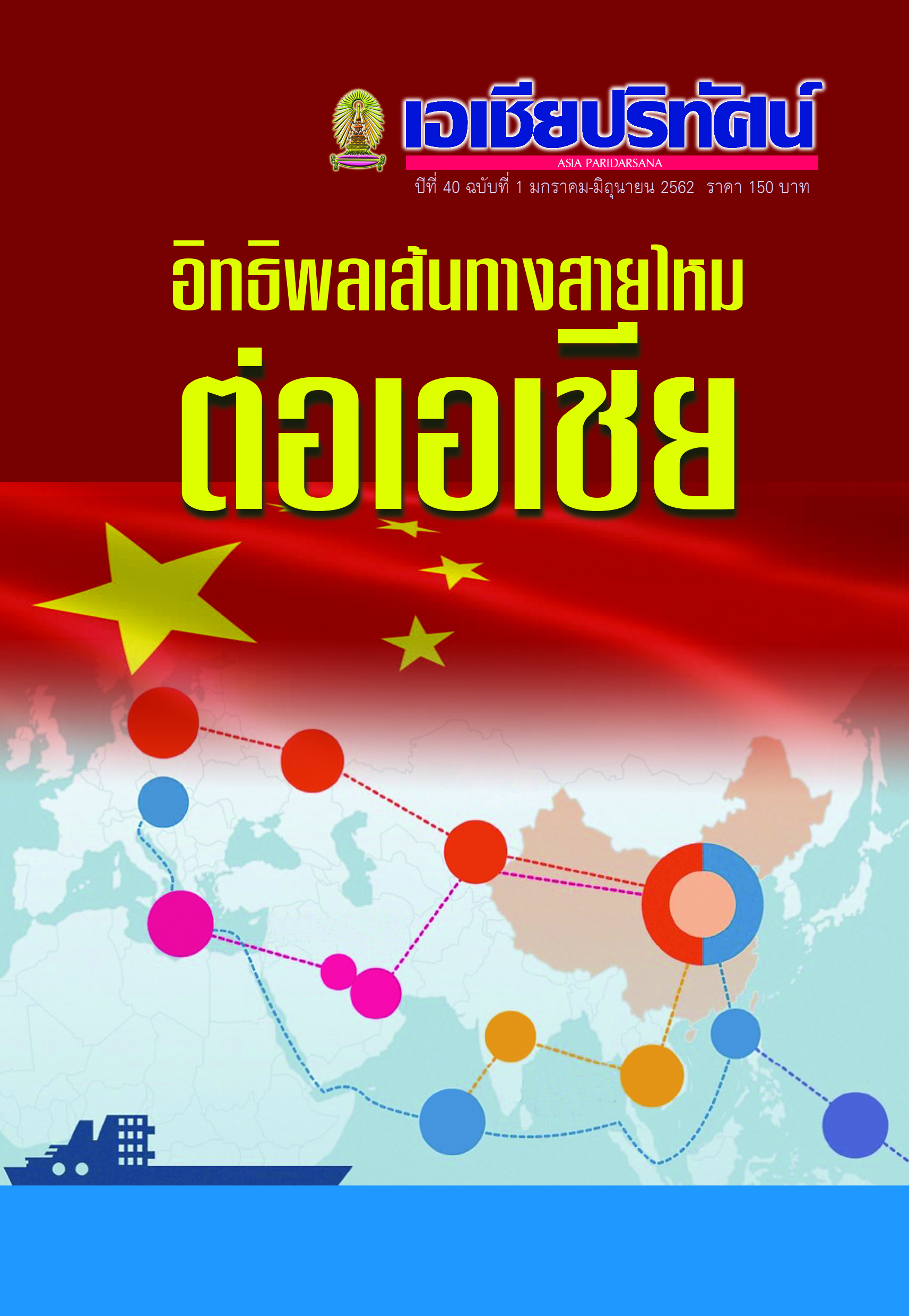“นโยบายเส้นทางสายไหม” กับความสัมพันธ์ทางเศรษฐกิจระหว่างไทย-จีน และแนวโน้มการลงทุนจากญี่ปุ่นในประเทศไทย
Main Article Content
บทคัดย่อ
“นโยบายเส้นทางสายไหม” ภายใต้โครงการ “หนึ่งแถบหนึ่งเส้นทาง” เป็นนโยบายสำคัญของจีน ภายใต้แนวคิดริเริ่มสู่วิสัยทัศน์กว้างไกลของประธานาธิบดี สี จิ้นผิง ผู้นำพรรคคอมมิวนิสต์รุ่นที่ 5 โดยกำหนดแผนพัฒนาเศรษฐกิจ ฉบับที่ 13 ของจีน ที่ต้องการเปลี่ยนโครงสร้างทางเศรษฐกิจจากการเป็นโรงงานผลิตของโลก มุ่งเน้นกลยุทธ์ด้านการส่งออก เป็นการออกสู่ตลาดโลก ด้วยยุทธศาสตร์ “หนึ่งแถบหนึ่งเส้นทาง” จีนจึงขยายโครงสร้างด้านสาธารณูปโภคขนาดใหญ่เชื่อมโยงเครือข่ายคมนาคมทางบกและทางทะเล กับ 60 กว่าประเทศทั่วโลก ระหว่างทวีปเอเชีย ยุโรป ตะวันออกกลาง และแอฟริกา เข้ากับภูมิภาคต่างๆ ของโลก ผ่านการสนับสนุนเงินทุนจากธนาคารเพื่อการพัฒนาโครงสร้างพื้นฐานแห่งเอเชีย การศึกษาในครั้งนี้จึงมีวัตถุประสงค์เพื่อ (1) ศึกษาความสัมพันธ์ทางเศรษฐกิจไทย-จีนภายใต้นโยบายเส้นทางสายไหม และ (2) เพื่อศึกษาแนวโน้มการลงทุนจากประเทศญี่ปุ่นในไทย นับจากการริเริ่มโครงการ “หนึ่งแถบหนึ่งเส้นทาง” โดยใช้ระเบียบวิธีวิจัยเชิงคุณภาพ เก็บรวมรวมข้อมูลเชิงเอกสารเฉพาะนโยบายเส้นทางสายไหมของจีน ที่เกี่ยวข้องกับความสัมพันธ์ทางเศรษฐกิจระหว่างไทย - จีน รวมถึงแนวโน้มการลงทุนจากประเทศญี่ปุ่น และนำข้อมูลที่ได้มาวิเคราะห์สรุปผลเชิงพรรณนา
Article Details
เอกสารอ้างอิง
“จีนขยายอิทธิพลท้าทายมะกันผลักดันแผนเชื่อมโยงภูมิภาค.” 2557.ประชาชาติธุรกิจออนไลน์,13 พฤศจิกายน.http://www.prachachat.net/news_detail.php?newsid=1415857507
ชนกพร ทองตากรณ์ และสมปฤณ นิยมไทย. 2561. “วิเคราะห์ “นโยบายเส้นทางสายไหมในคริสต์ศตวรรษที่ 21” ของจีน.” วารสารรัฐประศาสนศาสตร์ 16(1): 95-126.
ไชยสิทธิ์ ตันตยกุ. 2561. “แนวทางการเชื่อมโยงยุทธศาสตร์ “หนึ่งแถบ หนึ่งเส้นทาง” (Belt and Road Initiative : BRI หรือ One Belt, One Road : OBOR) ของรัฐบาลจีน กับยุทธศาสตร์“ประเทศไทย ๔.๐” และ “นโยบายการพัฒนาระเบียงเศรษฐกิจภาคตะวันออก (Eastern Economic Corridor : EEC).” 25 ธันวาคม. ศูนย์วิจัยยุทธศาสตร์ไทย-จีน, http://www.vijaichina.com/articles/826
“ดร.จื้อกัง หลี่” ประธานแบงก์ไอซีบีซีไทย มองการลงทุนจีน – ไทยผ่าน One Belt, One Road เชื่อมต่อ EEC.” 2561. Thaipublica, 28 มิถุนายน. https://thaipublica.org/2018/06/icbc-thai-china-eec-onebelt-oneroad/.
ปณต แสงเทียน. 2558. “ยุทธศาสตร์เส้นทางสายไหมทางทะเลของจีน ความเกี่ยวข้องต่ออาเซียนและเอเชียตะวันออกเฉียงใต้.” วารสารรัฏฐาภิรักษ์ 57(3): 49-61.
เปเป้ เอสโคบาร์. 2560. “แผนหนึ่งแถบหนึ่งเส้นทางเปลี่ยนจีนและเปลี่ยนโลก.” ผู้จัดการออนไลน์, 18 พฤษภาคม.https://mgronline.com/around/de¬tail/9600000050183
ลม เปลี่ยนทิศ. 2560. “ความฝันของชาวจีน Chinese Dream.” Thairath Online, https://www.thairath.co.th/ content/1102684
สมบัติ ธำรงธัญวงศ์, จุฬาภรณ์ ขอบใจกลาง และหลี่ เหรินเหลียง. 2559. “ความสัมพันธ์เศรษฐกิจไทย-จีน ภายใต้การเปลี่ยนแปลงของเศรษฐกิจโลก.” วารสารพัฒนาสังคม 18(2): 127-154.
สันติ ตั้งรพีพากร. 2547. ยุทธศาสตร์ 3 ก้าว สู่ความสำเร็จแบบจีน. กรุงเทพฯ: สำนักพิมพ์มติชน.
สำนักงานคณะกรรมการส่งเสริมการลงทุน. 2560. รายงานภาวะการลงทุนโดยตรงจากต่างประเทศในประเทศไทย. (มกราคม-ธันวาคม)
อุกฤษฎ์ ปัทมานันท์. 2560. “เขตเศรษฐกิจพิเศษชายแดนไทยกับอาเซียน: ภูมิภาคนิยม รัฐและทุน.” วารสารสังคมวิทยามานุษยวิทยา 36(1): 9-26.
ฮูเชี้ย เชน .2559. โอกาสของประเทศไทยภายใต้นโยบาย OBOR. การบริหารเศรษฐกิจสาธารณะสำหรับนักบริหารระดับสูง รุ่นที่ 15 สถาบันพระปกเกล้า.
Asian Development Bank. 2018. Asian Development Outlook (ADO) 2018: How Technology Affects Jobs. Accessed November 11, 2018. https://www.adb.org/sites/default/files/publication /411666/ado2018.pdf
Grieger, Gisela. 2561. OBOR (OBOR): China’s regional integration initiative. International Institute for Asian Studies OBOR.
International Monetary Fund. 2561. “World Economic Outlook April 2018 Cyclical Upswing, Structural Change.” Washington, DC: In¬ternational Monetary Fund.
Li, X. 2560. “The Silk Road economic belt: Strategy or tactic underpinning the “Chinese Dream”?.” Northeast Asia Forum 118 (2)
Lindemann, Bjorn Alexander. 2556. Cross-Strait relations and internation¬al organizations. Wiesbaden: VS Verlag fur Sozialwissenschaften. Accessed November 2, 2018.https://iias.asia/the-newsletter/article/one-belt-one-road-japanese-perspective
Sheng, Y.,Yu, H., and C. Yue .2015. A Summary on the “OBOR ” Strat¬egy Connotation, Characteristics and Strategy Focuses. Reform of Economic System 2015(1)
Yuan, X, (2014). Analysis of the national strategic “OBOR ” construction. Around Southeast Asia.


